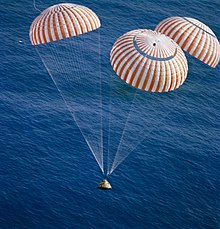Fe, Fi, Fo, Fum, and Phooey




Fe, Fi, Fo, Fum, and Phooey were five mice who traveled to the Moon and circled it 75 times on the 1972 Apollo 17 mission. NASA gave them identification numbers A3326, A3400, A3305, A3356, and A3352, and their nicknames were given by the Apollo 17 crew, Eugene Cernan, Harrison Schmitt, and Ronald Evans. The four male mice, one female mouse, and Evans orbited the Moon for six days and four hours in the Apollo command module America as Cernan and Schmitt performed the Apollo program's last lunar excursions. One of the mice died (A-3352[1]) during the trip, and the four others were killed and dissected for their intended biological information upon their successful return from the Moon.
The three astronauts and the five mice were the last Earthlings to travel to and orbit the Moon.[2] Evans and the five mice share two living-being spaceflight records: the longest amount of time spent in lunar orbit (147 hours 43 minutes), and the most lunar orbits traveled (75).[3]
Mission
Apollo 17 launched December 7, 1972, and returned to Earth on December 19. A biological cosmic ray experiment (BIOCORE) carried the five pocket mice (Perognathus longimembris), a species chosen for the experiment because they had well documented biological responses. Some advantages of the species included their small size, their ease of maintenance in an isolated state (requiring no drinking water for the expected duration of the mission and producing highly concentrated waste), and their proven capability of withstanding environmental stress.
Fe, Fi, Fo, Fum, and Phooey had been implanted with radiation monitors under their scalps to see whether they would suffer damage from cosmic rays.[4] Four of the five mice survived the flight; the cause of death of the fifth was not determined.[4]
After their return to Earth, the four remaining live mice were killed and dissected, and although lesions in the scalp and liver were detected they appeared to be unrelated to one another, and were not thought to be the result of cosmic rays. No damage was found in the mice's retinas or viscera.[4] At the time of the publication of the Apollo 17 Preliminary Science Report their brains had not yet been examined,[4] and subsequent studies however showed no significant effect on the mice's brains.[1]
See also
- Animals in space
- Zond 5, a Soviet space program circumlunar voyage in September, 1968, by two tortoises and assorted small plants and insects. They were the first and only other non-human lifeforms to both fly to the vicinity of the Moon and to return safely
- Fee-fi-fo-fum, the namesake portion of the English fairy tale "Jack and the Beanstalk"
References
- ^ a b Haymaker, Webb; Look, Bonne C.; Benton, Eugene V.; Simmonds, Richard C. (January 1, 1975). "The Apollo 17 Pocket Mouse Experiment (Biocore)". In Johnston, Richard S.; Berry, Charles A.; Dietlein, Lawrence F. (eds.). SP-368 Biomedical Results of Apollo (SP-368). Lyndon B. Johnson Space Center. OCLC 1906749.
{{cite book}}: External link in|chapterurl=|chapterurl=ignored (|chapter-url=suggested) (help) - ^ Burgess, Colin; Dubbs, Chris (July 5, 2007). Animals in Space: From Research Rockets to the Space Shuttle. Springer Science & Business Media. p. 320. ISBN 9780387496788. Retrieved May 4, 2016.
- ^ NASA Apollo 17 page
- ^ a b c d Bailey. O.T.; et al. (1973). "26. Biocore Experiment". Apollo 17 Preliminary Science Report (NASA SPP-330).

